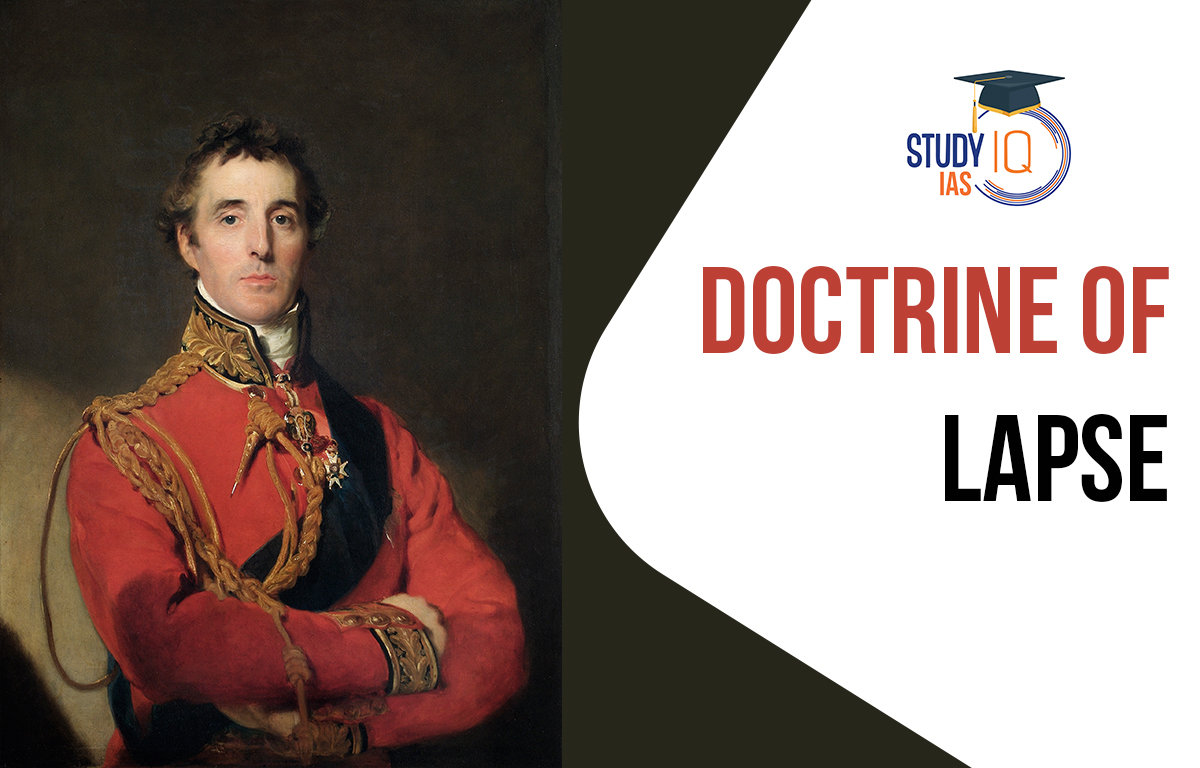Table of Contents
Doctrine of Lapse
The Doctrine of Lapse was a policy applied by the British East India Company in India during the mid-19th century, primarily during the administration of Governor-General Lord Dalhousie (1848–1856). The doctrine was part of the British strategy to expand and consolidate its control over Indian princely states.
Who was Lord Dalhousie?
- First Marquess of Dalhousie James Andrew Broun-Ramsay, also known as Lord Dalhousie, served as acting governor-general of India from 1848 to 1856. He was a well-known Scottish lawmaker.
- Even though Lord Dalhousie is famous for being connected to the Idea of Lapse, the East India Company’s Court of Directors took the decision as early as 1847, and other minor states had already been added to the convention before he was appointed Governor-General.
- He applied the strategy more widely to increase the East-India Company’s regional influence.
- The East India Company also extensively used a policy known as the Doctrine of Lapse in India. If a royal state’s ruler failed to provide a beneficiary, the notion declared that each state under the organization’s vassalage would gain its territory.
- Many Indians thought the theory and its application were flawed. The Doctrine of Lapse doctrine was one of the main factors contributing to the 1857 uprising.
History of Doctrine of Lapse
At the time of its receipt, the East India Company possessed royal regulatory jurisdiction over vast areas of the continent. The company took over the prestigious lands of Satara (1848), Bhagat (1850), Jaitpur and Sambalpur (1849), Udaipur (Chhattisgarh) (1852), Nagpur (1854), Jhansi (1853), Tore and Arcot (1853) under the assumption of a pass (1855). Oudh (1856) was added under the Doctrine of Lapse, as is typical. However, as far as anyone can tell, ruler Dalhousie held on to its misgovernance.
By arguing that the monarch was not governing efficiently, this type of thought helped the company earn about 4,000,000 pounds extra in profit each year. Hatred erupted among several facets of Indian society as a result of the East India Company’s growing influence, especially among disbanded warriors who fueled the evicted governments during the 1857 Indian Rebellion, also known as the Sepoy Mutiny. The philosophy was abandoned in 1858 by the new British Viceroy of India, whose authority exceeded that of the East India Company.
By putting into practice a “policy of slip by,” the East India Company took over the August province of Kittur, which was represented by Queen Chennamma, in 1824. Lord Dalhousie may not have actually created it in 1848, but by documenting it, he may have given it legal status. Dalhousie’s extensions and the concept of the pass were questioned by the majority of India’s powerful rulers.
Key Features of Doctrine of Lapse
- Succession Rule: The doctrine dictated that if a ruler of a princely state died without a natural male heir, the state would “lapse” or be annexed by the British. The state could not pass to an adopted heir unless explicitly approved by the British authorities.
- Adoption Disallowed: Traditional Indian customs often allowed rulers to adopt sons to succeed them in the absence of biological heirs. However, the British disregarded these practices under the doctrine.
- Legitimization of Annexation: The British East India Company used this policy as a legal pretext to take control of territories where the rulers were either deemed incompetent or where the ruler had died without a direct male successor.
Annexed States under Doctrine of Lapse
| State | Year | |
| Satara | 1848 | |
| Jaitpur | 1849 | |
| Sambalpur | 1849 | |
| Baghat | 1850 | |
| Udaipur | 1852 | |
| Jhansi | 1853 | |
| Nagpur | 1854 | |
Because of this, the British came to India for trade, but their desire to control the country’s resources led them to become quite powerful there. The Doctrine of Lapse was essentially an expansionist strategy used by the British East India Company to capture nearby Indian territories in an effort to make the British Empire appear more realistic.
Dalhousie put this in place so that the British East India Company could obtain monopolistic control over the Indian state and boost revenue. As a result, the British were despised and fiercely opposed by the rulers of the various states, which fueled the 1857 uprising.
Impacts of Doctrine of Lapse
The doctrine was highly unpopular among Indian rulers and subjects, as it undermined the traditional rights of succession and disregarded Indian customs. This, combined with other policies of annexation and mismanagement, contributed to widespread resentment against British rule, culminating in the Indian Rebellion of 1857 (also known as the First War of Indian Independence).
After the rebellion, the policy of the Doctrine of Lapse was formally abandoned when the British Crown took direct control of India from the East India Company.
Due to the lack of a biological heir to the throne, several of the Indian princely states lost their lands to the British East India Company under the Doctrine of Lapse. After the policy’s empowerment, a large number of Indian princes lived unhappy lives, which ultimately contributed to the Revolt of 1857.
Nana Sahib and the Rani of Jhansi had issues since the pensions for the heirs were restricted and treated disrespectfully. The introduction of the policy prevented the Rani of Jhansi’s adoptive son from succeeding to the throne. After Lord Dalhousie, the Governor General, left for Britain in 1856, a revolt broke out in 1857, which led to harsh criticism of Lord Dalhousie’s leadership.
| Other Important Articles | |
| Freedom Fighters of India | Princely States in India |
| Chauri Chaura Incident | Jallianwala Bagh Massacre |
| Quit India Movement | Non-Cooperation Movement |


 Nagari Pracharini Sabha Revival: Backgro...
Nagari Pracharini Sabha Revival: Backgro...
 Ryotwari System in India, Features, Impa...
Ryotwari System in India, Features, Impa...
 Battle of Plassey, History, Causes, Impa...
Battle of Plassey, History, Causes, Impa...





















